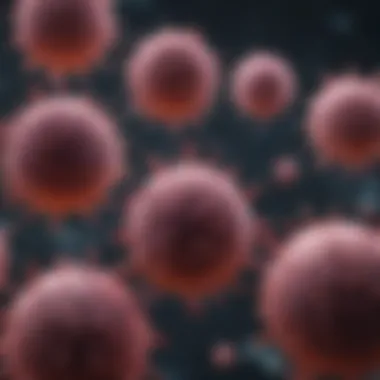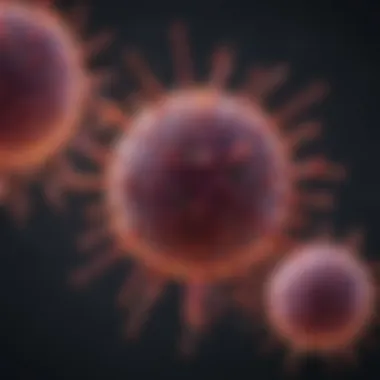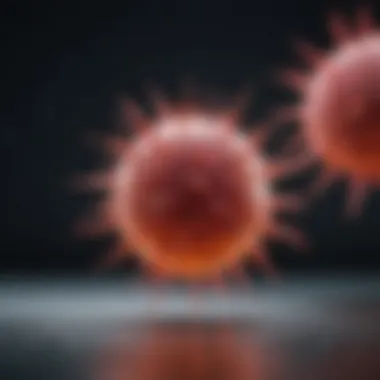T Cells: Key Players in the Cancer Immune Response


Intro
The world of immunology, especially the role of T cells, holds considerable promise in the ongoing battle against cancer. T cells, a type of lymphocyte, play a vital part in the adaptive immune response, shaping how our body reacts to various pathogens and tumor cells. As researchers delve deeper into the mechanisms of T cells, it becomes clear that understanding their interplay with cancer is not just an academic exercise but crucial for developing effective therapies.
T cells can identify and destroy abnormal cells, making them an invaluable asset in oncological treatments. This article strives to explore the detailed relationship between T cells and cancer, shedding light on their capabilities, limitations, and the innovative approaches now being harnessed to better deploy them in clinical settings.
Through a blend of emerging techniques, current trends, and significant discoveries, this discussion aims to equip readers—be they students, educators, or professionals—with a nuanced understanding of how T cells contribute to the immune response against tumors.
Given the relevance of T cells in the realm of cancer research, we now find ourselves at a juncture where further exploration is not just desired but essential.
Research Overview
Methodological Approaches
In the investigation of T cells and their relation to cancer, scientists have employed a variety of methodological approaches. These range from in vivo studies involving animal models to the intricate mechanisms observed through in vitro experimentation. Techniques such as flow cytometry and single-cell RNA sequencing are now cutting-edge tools that give insight into T cell populations and their responses to tumor microenvironments.
Flow cytometry, for instance, allows researchers to analyze the characteristics of individual T cells. This provides insights into the activation, proliferation, and differentiation of T cells in response to tumors. Meanwhile, single-cell RNA sequencing sheds light on the diverse functionalities and states of T cells within the tumor milieu, painting a complete picture of the immune landscape.
Significance and Implications
The implications of understanding T cells are profound. By deciphering their exact roles, researchers can enhance existing therapies or develop new ones that utilize T cells more effectively.
"When we grasp the intricate dance between T cells and cancer, we can better strategize our efforts in immunotherapy, paving the way for personalized medicine."
Furthermore, recognizing the hurdles T cells encounter when battling cancer cells opens avenues for therapeutic interventions. Factors such as tumor-induced immunosuppression and T cell exhaustion present significant challenges. Researchers aim to address these obstacles through innovative solutions like checkpoint inhibitors and CAR T-cell therapy.
Current Trends in Science
Innovative Techniques and Tools
In a rapidly evolving field, the introduction of innovative techniques is changing how we perceive T cells within the cancer landscape. Technologies such as CRISPR gene editing offer exciting prospects for modifying T cells to enhance their anti-tumor effects. Additionally, biomarkers for T cell activation serve as crucial indicators in understanding how well a treatment is working.
The convergence of big data and machine learning also holds immense potential in predicting how T cells will respond to specific cancer therapies, enabling more tailored and effective treatments.
Interdisciplinary Connections
The interaction between T cell research and other scientific fields cannot be overstated. As oncologists, immunologists, and data scientists collaborate, they contribute unique perspectives that enrich the understanding of T cells. The way in which T cells interact with microbiomes and metabolomics represents a burgeoning area ripe for exploration.
As we continue to explore these intersections, the potential for groundbreaking advancements in cancer treatment becomes even clearer. The road ahead is filled with possibility, fueled by ever-evolving scientific inquiry and collaboration.
Prolusion to T Cells
T cells play a pivotal role in the body's defense against cancer, representing a key component of the adaptive immune response. Their understanding is essential for comprehending how immune defenses are mobilized against tumors and how those defenses can be harnessed for therapeutic purposes. The fascinating dynamics of T cell behavior, from activation to execution of immune functions, shed light on potential pathways for innovative cancer treatments.
In this article, we aim to unravel the complex interplay between T cells and the intricacies of cancer immunity. By examining how T cells function, their different types, and their specific roles in combating cancer cells, we illuminate the roadmap for future research and application in immunotherapy.
Definition and Function
T cells, a subset of lymphocytes originating in the bone marrow and maturing in the thymus, are essential players in the immune system. Their primary duty is to identify and eliminate infected or dysfunctional cells, including tumor cells. Comprised mainly of CD4+ helper T cells and CD8+ cytotoxic T cells, they operate through a sophisticated recognition system that includes T cell receptors (TCRs). When T cells recognize abnormalities in a cell's surface proteins—often caused by infection or cancer—they spring into action and initiate an immune response.
Types of T Cells
Understanding the various types of T cells is crucial in appreciating their multifaceted roles in the immune response against cancer. Each subtype possesses unique capabilities and plays distinct roles in regulating immune actions.
CD4+ T Cells
CD4+ T cells, often referred to as helper T cells, are the coordinators of the immune system. They help other immune cells mount responses against pathogens and tumors. The key characteristic of CD4+ T cells is their ability to enhance the activity of B cells and CD8+ T cells through cytokine signaling. This makes them a focal point of interest in immunotherapy, as their activation can amplify the overall immune response against cancer.
A unique feature of CD4+ T cells is their ability to differentiate into various subsets, such as T and T, each playing specialized roles in the immune response. The advantage of targeting CD4+ T cells in cancer treatment is that boosting their function can lead to a more robust anti-tumor response. However, the flip side is that overactivity in this cell type can also contribute to autoimmune conditions in certain contexts.
CD8+ T Cells
CD8+ T cells, known for their cytotoxic capabilities, directly kill cancerous cells. They are characterized by their high levels of perforin and granzymes, which they use to induce apoptosis in aberrant cells. Their potency against tumors makes them a preferred candidate for innovative cancer therapies, particularly adoptive cell transfer methods.
A defining feature of CD8+ T cells is their ability to form memory cells—ensuring a faster and more efficient response upon subsequent encounters with the same antigen. This memory aspect provides a significant advantage in long-term cancer control but can lead to challenges when tumors diversify, creating antigen variability.
T Regulatory Cells
T regulatory cells (Tregs) play a somewhat paradoxical role in cancer immunity. While they help maintain immune tolerance and prevent autoimmunity, they can also inhibit anti-tumor immune responses. The main characteristic of Tregs is their expression of the CD25 marker and the transcription factor FoxP3, which are critical for their regulatory functions.
A unique feature of Tregs is their ability to modulate other T cells, often suppressing their reaction to tumor cells, which can be detrimental in the context of cancer treatment. Understanding the balance between their immunosuppressive role and the need for potent anti-tumor immunity is vital when considering Tregs in therapeutic strategies. While Tregs can assist in controlling excessive immune responses, their elevation in tumors often presents a hurdle in effective immunotherapy.
The Immune System and Cancer
The relationship between the immune system and cancer is a complex dance that spans biology, genetics, and even environmental factors. Understanding this connection is crucial, as it informs both the mechanisms of tumor development and the strategies employed to combat cancer. Much of the research into the immune response to cancer focuses on how T cells work, but the broader immune system plays a significant role in identifying and eliminating abnormal cells.
A well-functioning immune system can recognize malignancies early on, targeting cancerous cells before they proliferate extensively. This proactive role is essential, considering how adept tumors can be at hiding from immune detection using various evasion strategies. More than just a battleground, the immune landscape entails various interactions, from inflammatory responses to cell communication.
Amongst the immune components, T cells are pivotal in determining the outcome of cancer development. Their ability to recognize and destroy tumor cells makes them prime candidates for immunotherapeutic interventions. A deep understanding of their actions, coupled with the immune response's intricacies, allows researchers and clinicians to design better therapeutic strategies.
Overview of the Immune Response
The immune response consists of a coordinated set of reactions aimed at protecting the body against pathogens and abnormal cells. It operates through two main branches: the innate immune response, which acts as the first line of defense, and the adaptive immune response, which is more targeted and specific.


- Innate Immune Response:
- Adaptive Immune Response:
- Fast Acting: This response is immediate and non-specific. It includes physical barriers like the skin, as well as immune cells like macrophages and dendritic cells that can consume pathogens and alert the adaptive system.
- Inflammation: An infectious agent’s presence triggers inflammation, increasing blood flow to the area. This brings in additional immune cells to fight off the invaders.
- Specificity: This response develops over time. Key players are T cells and B cells, which recognize specific antigens presented by pathogens or tumor cells.
- Memory Formation: After an encounter with an antigen, a portion of these cells persists, allowing for a quicker response if the same pathogen is encountered again.
A critical aspect of this response is the role of antigen presentation. Dendritic cells and other antigen-presenting cells process foreign or abnormal proteins and present them to T cells. This recognition is essential for T cell activation, allowing the immune system to mount a precise attack against cancer cells.
Cancer as a Complex Disease
Cancer is not merely a single disease; it encompasses a myriad of conditions characterized by uncontrolled cell growth and spread. Various factors contribute to this complexity, ranging from genetic mutations and environmental influences to the individual’s immune system.
- Genetic Heterogeneity: Each tumor can have a unique genetic makeup, leading to variations in how cancer cells behave and how they respond to treatment. This diversity can create challenges in targeting them effectively.
- Microenvironment: The tumor’s surroundings, including blood vessels, immune cells, and extracellular matrix, can significantly influence cancer progression. Some immune cells present in the tumor microenvironment may even foster tumor growth, creating a paradoxical situation where the immune system’s elements promote disease instead of combating it.
- Evasion Strategies: Cancer cells have evolved numerous tactics to evade immune detection. These include downregulating antigen expressions, secreting immunosuppressive factors, and modifying their microenvironment to inhibit immune cell activity.
These complex attributes underscore the need for a sophisticated approach in both research and therapy. To effectively combat cancer, innovative methodologies must account for the unique characteristics of tumors and their intricate interplay with the immune system.
Mechanisms of T Cell Action in Tumor Environments
The interplay between T cells and cancer is complex, where understanding how T cells act within tumor environments offers crucial insights into immuno-oncology. This section focuses on the mechanisms of T cell action, highlighting their activation, migration to tumors, and effector functions. Knowing how T cells operate not only widens the scope on cancer biology but also opens avenues for effective therapies that might leverage these immune cells.
T Cell Activation
Activation of T cells is the first step towards their effectiveness in combating cancer cells. Without proper activation, these cells would remain dormant, incapable of mounting a defense against malignancies.
T Cell Receptor Interaction
At the heart of T cell activation lies the T cell receptor (TCR) interaction with peptide-bound Major Histocompatibility Complex (MHC) molecules on antigen-presenting cells. This interaction is a crucial event. When TCR binds with its corresponding peptide-MHC complex, it triggers a cascade of intracellular signals that lead to T cell proliferation and differentiation.
A key characteristic of TCR interaction is its specificity. It is selective in recognizing distinct peptides, which can be highly advantageous when targeting tumors with unique neoantigens. However, the downside is that TCRs can have a high affinity for self-antigens, leading to potential autoimmunity if misregulated.
The unique feature here is the role of co-stimulatory signals, often provided by molecules like CD28, which enhance the T cell response. These signals can determine the fate of T cell responses, whether they become effective killer cells or are left inactive. This duality showcases both a benefit and a concern in designing T cell-based therapies.
Cytokine Signaling
Cytokines play a vital part in the activation phase. These small signaling molecules mediate communication between T cells and other immune cells. When T cells encounter their specific antigens, they release cytokines such as interleukin-2 (IL-2), which encourages T cell proliferation.
What makes cytokine signaling a beneficial choice for this discussion is its profound impact on shaping the immune response. Perhaps its greatest strength lies in enhancing T cell survival and functionality within the hostile tumor microenvironment. The downside, however, is that excessive or unregulated cytokine signaling can lead to a hyperactive immune response, which may contribute to tissue damage and systemic inflammatory issues.
T Cell Migration to Tumors
T cell efficacy extends beyond activation; it also entails the migration of these cells into tumor sites, where they can exert their functions. Understanding this migration process helps to identify barriers that may hinder successful therapy.
Trafficking Mechanisms
The term trafficking refers to how T cells move from the bloodstream to the site of the tumor. This involves several mechanisms, including rolling along the endothelium, activation, adhesion, and transmigration. A unique characteristic of this process lies in the selective expression of adhesion molecules, which ensures that T cells are guided to the right place at the right time.
Trafficking mechanisms are essential for effective T cell responses against cancer. However, the tumor microenvironment can develop barriers that inhibit T cell action. A specific risk here is the creation of a dense extracellular matrix in tumors that complicates T cell migration, effectively trapping them away from where they are needed.
Chemokine Gradient Responses
Chemokines are critical for guiding T cells to tumor sites. When released, they create a gradient that T cells can sense and follow—much like a breadcrumb trail. This chemokine signaling is significant for promoting localized T cell responses against cancer.
The major upside of chemokine gradient responses is their ability to enhance the recruitment of T cells precisely where they are needed. The flip side is that tumors can exploit these pathways using abnormal chemokine secretion, which may confuse T cells or even promote retention of Tregs (regulatory cells) that can inhibit the anti-tumor response.
T Cell Effector Functions
Once T cells have navigated and infiltrated the tumor environment, it is their effector functions that become paramount. This final phase is where T cells take direct action against cancer cells.
Cytotoxic Activity
T cells are equipped with the ability to kill tumor cells. In particular, CD8+ T cells are known for their cytotoxic potential. This group can recognize tumor antigens presented by MHC Class I molecules, after which they deploy granules containing perforin and granzymes to induce apoptosis in the target cells.
This characteristic makes cytotoxic activity pivotal in the war against cancer. However, there is also the danger of off-target effects—non-target cells can be accidentally harmed during these attacks. The careful balancing of cytotoxic functions is essential to enhance efficacy while minimizing collateral damage.
Cytokine Production
In addition to cytotoxic mechanisms, T cells engage in cytokine production, releasing cytokines that can further modulate the immune landscape. These signals can help recruit additional immune cells to the tumor site and enhance the overall immune response against the malignancy.
The impressive versatility of cytokine production allows for the potential amplification of anti-tumor responses, making it a beneficial area of focus. However, the caveat lies in the fact that some cytokines can have immunosuppressive effects if released excessively, potentially aiding tumor survival. This aspect underscores the need for a refined understanding of cytokine dynamics in tumor settings.
"T cell interactions act as a double-edged sword—crucial for immune function but also potentially harmful if not properly regulated."
Through this nuanced examination of T cell actions, it's evident that the mechanisms governing these immune cells are intricate, and understanding them is paramount for the advancement of cancer therapies. Ultimately, T cells harbor the potential to serve as powerful agents in the fight against cancer, but the journey is fraught with challenges that must be navigated carefully.
Tumor Evasion Mechanisms
Understanding tumor evasion mechanisms is critical when discussing the role of T cells in cancer. Tumors possess intricate strategies to evade immune detection and destruction. This ability not only facilitates their survival but also underscores the necessity for targeted therapies that focus on overcoming these defenses. Investigating how tumors manipulate immune responses allows researchers to design better interventions that can either reinvigorate T cells or reorient the immune environment towards an antitumor state. In this regard, tumor evasion mechanisms shine a light on the complex interplay between cancer cells and the immune system, emphasizing that the fight against cancer is as much about outsmarting the enemy as it is about eliminating it.
Immune Checkpoints
CTLA-4
CTLA-4, or cytotoxic T-lymphocyte-associated protein 4, is a significant player in the immune checkpoint landscape. This protein acts as a brake on T cells, regulating their activation. Its primary contribution involves inhibiting the proliferation of T cells during the immune response, effectively dampening the overall activity of the immune system.


One key characteristic of CTLA-4 is its ability to compete with the co-stimulatory molecule CD28 for binding to B7 molecules (CD80/CD86) on antigen-presenting cells. This competition serves to fine-tune the response of T cells, providing a check against excessive immune reactions, which can lead to autoimmunity. However, this same mechanism is often exploited by tumors to avoid immune detection.
The unique feature of CTLA-4 lies in its targeted intervention. By blocking CTLA-4, therapies like ipilimumab have proved effective in unleashing T cells against tumors. The advantages of utilizing CTLA-4 inhibitors include the potential for longer-lasting immune responses. However, the downside includes the risk of autoimmunity, where the unleashed immune response may turn against normal tissues, causing adverse effects that can complicate treatment.
PD-1/PD-L1 Pathway
The PD-1/PD-L1 pathway is another crucial mechanism utilized by tumors to evade immune scrutiny. The programmed death-1 (PD-1) protein is expressed on T cells and interacts with its ligand, PD-L1, found on many cancer cells. This interaction leads to the inhibition of T cell activation and proliferation, further allowing tumors to escape immune responses.
A key characteristic of this pathway is its role in maintaining immune tolerance. In normal physiological conditions, PD-1 engagement helps to prevent autoimmunity. However, tumors co-opt this pathway as a survival strategy. The power of PD-1 inhibitors, such as pembrolizumab and nivolumab, stems from their ability to disrupt this inhibitory signal, enabling T cells to recognize and attack cancer cells more effectively.
The PD-1/PD-L1 pathway's unique feature is its capability to generate robust antitumor responses, which can lead to durable remissions in some patients. Yet, similar to CTLA-4 blockers, PD-1 inhibitors also present a risk of immune-mediated side effects, which can range from manageable to severe, depending on the individual patient's response. This balance between effective cancer treatment and the potential for autoimmunity is a central concern in modern immunotherapy.
Tumor Microenvironment Factors
Immunosuppressive Cells
The tumor microenvironment is a hotbed of factors that counteract effective immune responses, particularly through the action of immunosuppressive cells. This subset of cells, which includes regulatory T cells, myeloid-derived suppressor cells (MDSCs), and tumor-associated macrophages (TAMs), can profoundly impact the efficacy of T cell responses against tumors.
One of the most crucial characteristics of immunosuppressive cells is their ability to create an environment that favors tumor growth over immune activation. For instance, MDSCs can inhibit T cell proliferation and activity through the secretion of various soluble factors, essentially creating a biological moat around the tumor. They are a popular focus in research due to their ability to modulate immune responses in cancer.
The unique feature of immunosuppressive cells is their collective contribution to what researchers describe as an immune suppressive microenvironment. This environment skews T cell functions away from antitumor activity. While targeting these cells is promising, the challenge is to ensure that such interventions won’t inadvertently ramp up systemic autoimmunity, thus complicating cancer treatment strategies.
Metabolic Alterations
Metabolic alterations within tumors represent another layer of complexity regarding immune evasion. Cancer cells often undergo metabolic reprogramming that influences T cell activation and function. For instance, tumors can alter the availability of essential nutrients, such as glucose and amino acids, thereby affecting T cell metabolism and their ability to mount effective immune responses.
A significant characteristic of metabolic alterations is the competitive inhibition they create. Tumors may thrive in nutrient-deprived environments while starving T cells of the resources they need. This metabolic competition is a growing area of interest, particularly in the context of combination therapies aimed at restoring T cell function through metabolic support.
The unique feature of targeting metabolic pathways is that altering the tumor microenvironment to provide T cells with the necessary nutrients can rejuvenate their activity and resilience. While promising, this approach must be balanced with the challenge that not all tumors share the same metabolic profiles, which complicates the development of broad-spectrum treatments.
In summary, tumor evasion mechanisms illustrate the multifaceted strategies employed by cancer cells to survive against immune attacks, underscoring the pressing need for innovative therapeutic approaches that can effectively counteract these tactics.
T Cell-Based Therapies
T cell-based therapies mark a pivotal advancement in cancer treatment, harnessing the body's own immune response to specifically target and eradicate tumors. These therapies offer unique avenues for enhancing patient survival rates and improving quality of life. As research delves deeper into the capabilities of T cells, it's becoming increasingly clear that these cellular interventions can drastically shift the landscape of cancer treatment. This segment outlines key methodologies like adoptive cell transfer, immune checkpoint inhibitors, and combination therapies, emphasizing their relevance to modern oncology.
Adoptive Cell Transfer
T Cell Engineering
In the realm of T cell-based therapies, T cell engineering stands out as a groundbreaking approach. This involves modifying a patient’s own T cells to improve their ability to recognize and combat cancer cells. The key characteristic of T cell engineering is its personalized nature; it tailors treatments based on an individual's tumor antigens, aiming to enhance the immune response. This specificity makes it a popular choice in current research and clinical settings.
A unique feature of T cell engineering is gene editing, particularly the use of CRISPR technology. This allows researchers to knock out certain genes and insert new ones to boost T cell effectiveness against tumors. However, while the advantages are significant—like reduced off-target effects—there are also challenges, including the potential for unintended consequences in the patient's immune system that need careful consideration.
CAR T Cell Therapy
CAR T cell therapy represents a cutting-edge frontier in cancer treatment. The focus here is on chimeric antigen receptors (CARs), genetically engineered receptors that direct T cells to target specific cancer cells. Its hallmark aspect is the ability to modify T cells to improve their recognition of specific tumor markers, thus creating a more focused attack against cancer. Given its success in treating hematologic malignancies, it has emerged as a prominent choice in therapeutic arenas, capturing widespread attention among researchers and clinicians alike.
The unique feature of CAR T cell therapy lies in the dual action mechanism: once these engineered cells are infused back into the patient, they proliferate and persist longer, creating a robust and enduring defense against cancer. However, this therapy does come with some drawbacks. While effective, it can lead to severe side effects, such as cytokine release syndrome, which requires diligent monitoring during treatment.
Immune Checkpoint Inhibitors
Mechanisms of Action
Understanding the mechanisms of action behind immune checkpoint inhibitors is crucial in appreciating their role in combating cancer. These inhibitors work by blocking the proteins that prevent T cells from attacking cancer cells, essentially removing the 'brakes' on the immune system. The main characteristic of these therapies is their ability to reinvigorate exhausted T cells, leading to a more effective immune response against tumors. Because of this mechanism, they are increasingly viewed as a formidable option in cancer therapy.
One of the prominent features of immune checkpoint inhibitors is their applicability across various cancer types. They have shown benefits in melanoma and lung cancer, among others, thus broadening their use. However, the effectiveness can vary from patient to patient. Some may experience significant responses, while others may not benefit at all, making it essential to investigate predictive biomarkers for better patient selection.
Clinical Applications
The clinical applications of immune checkpoint inhibitors are extensive, further underscoring their significance in oncology. They have radically changed the treatment paradigm for several cancers, offering new hope where conventional therapies may have failed. The essential characteristic here is their utility; these agents augment the immune system to target and eliminate cancer cells, often leading to durable responses.
Unique to these applications is the potential for combination strategies, where they can be paired with other forms of therapy, such as chemotherapy and radiation, enhancing overall effectiveness. Yet, the therapy can also raise safety concerns, including immune-related adverse events that complicate treatment. Balancing efficacy with safety is thus an ongoing challenge in the clinical setting.
Combination Therapies
Synergy with Chemotherapy
The exploration of synergy between T cell therapies and chemotherapy is a promising frontier in cancer treatment. By combining these approaches, clinicians aim to maximize tumor destruction while minimizing recurrence. The key characteristic of this synergy is their complementary mechanisms; while chemotherapy may directly kill cancer cells, T cell therapies can stimulate a robust immune response against remaining tumor cells.
A unique aspect of this approach is the potential for improved patient outcomes, as evidenced by some clinical trials demonstrating enhanced survival rates with combined therapies. However, the downside lies in the risk of increased toxicity, necessitating a careful balance to optimize treatment regimens without overwhelming patients.
Integrative Approaches
Integrative approaches further underscore the value of combining T cell therapies with other treatment modalities. This can include integrating immunotherapy with traditional options or utilizing adjunct therapies like lifestyle changes. The characteristic feature is the holistic management of cancer, where the goal is not just to target tumor cells, but also to improve overall well-being and quality of life.
A notable uniqueness of these integrative strategies is the potential to address the multifaceted nature of cancer, focusing on both psychological and physical health aspects. However, the complexities in coordinating multiple therapies can pose challenges in both planning and execution, making thorough interdisciplinary collaboration essential.
Modern T cell-based therapies hold immense potential, reshaping our approach to cancer treatment by leveraging the body's own immune responses.
In summary, T cell-based therapies represent a significant area of advancement in cancer research, offering diverse treatment options that improve outcomes and patient experiences. Understanding the nuances of these therapies, from their mechanisms to their clinical applications, is critical as the field continues to evolve.
Challenges in T Cell Immunotherapy


The journey to harness T cells for cancer treatment is paved with hurdles that can significantly impact their effectiveness. Understanding these challenges is paramount for researchers and clinicians alike. As T cell therapies gain momentum in oncology, recognizing the intricacies involved can lead to more effective strategies and improved patient outcomes. The focus here is primarily on three significant challenges: antigen heterogeneity, T cell exhaustion, and safety concerns.
Antigen Heterogeneity
Antigen heterogeneity refers to the variation of tumor antigens among different tumor cells within the same patient, or even between patients with the same type of cancer. This inconsistency can undermine the effectiveness of T cell therapies, especially those designed to target specific antigens. Due to this diversity, some tumor cells may express one set of antigens while others show a marked difference in their surface markers.
The implication of this variability is critical. Utilizing a T cell therapy that targets a prevalent antigen may yield success for some tumor cells but fail to eliminate others. This leads to issues such as tumor recurrence and treatment resistance. Researchers are looking into combinatorial approaches, where multiple antigens are targeted simultaneously, to tackle this issue more comprehensively.
T Cell Exhaustion
In the taxing battlefield of the tumor microenvironment, T cells often experience exhaustion. This phenomenon occurs when T cells are persistently activated in the presence of high levels of tumor antigens and immunosuppressive signals. Exhausted T cells exhibit reduced functionality, including diminished cytokine production and impaired cytotoxic abilities.
The recognition of T cell exhaustion has spurred interest in strategies aimed at rejuvenating these cells. Innovative therapies seek to reinvigorate exhausted T cells by blocking inhibitory receptors or adopting cytokine therapy to enhance their activity. The challenge here lies in finding the right balance; overstimulation can lead to further complications.
Safety Concerns
The power of T cell therapies is sometimes shadowed by potential safety concerns. As these therapies become more prevalent, two specific aspects require careful consideration: autoimmunity risks and toxicity management.
Autoimmunity Risks
Autoimmune reactions pose a substantial risk in T cell therapies. As engineered T cells are unleashed onto tumor cells, there remains a possibility of these immune cells misidentifying normal tissues as targets. Such misfire can lead to serious consequences, including tissue damage and new autoimmune disorders in patients.
What makes this worry wort is not just its occurrence but its unpredictability. Patients receiving T cell therapy often require close monitoring, and the degree of autoimmune response can vary widely between individuals. This variability can lead to complications not only during treatment but also long term.
Toxicity Management
As T cell therapies evolve, managing toxicity becomes an essential part of the treatment landscape. Patients may experience varying degrees of adverse effects, ranging from mild flu-like symptoms to severe reactions. Particularly, those undergoing CAR T cell therapy often face severe cytokine release syndrome, putting them at risk.
The key characteristic of effective toxicity management is identifying and addressing these adverse effects promptly. Strategies include using supportive care interventions and employing treatments like tocilizumab, which can mitigate severe symptoms. The balance lies in enhancing therapeutic efficacy while minimizing harm to the patient.
Future Directions in T Cell Research
As we delve into future directions in T cell research, it's crucial to emphasize the growing urgency of this topic. T cells play a pivotal role in the immune response, especially in cancer treatment. Emerging research suggests that harnessing their potential can lead to breakthroughs in personalized therapy, significantly improving outcomes for patients with various types of cancer. The landscape of cancer treatment is evolving rapidly, with T cells at the forefront of this transformation.
Personalized Cancer Vaccines
Personalized cancer vaccines stand out as a promising development in immunotherapy. These vaccines are tailored to the unique antigenic profile of a patient's tumor, allowing the immune system to specifically target and destroy cancer cells. The beauty of personalization here is that it takes into account the individual variations in tumor genetics, enhancing the effectiveness of the treatment.
Some of the advantages include:
- Increased efficacy: Tailored vaccines have shown improved responses compared to traditional, less specific vaccines.
- Reduced side effects: By focusing on tumor-specific antigens, normal cells are less likely to be targeted, minimizing collateral damage.
- Potential for combination with other therapies: They can be effectively combined with existing treatments, amplifying their overall effectiveness.
The challenge, however, lies in the complexity and cost of developing these personalized vaccines, which may limit their widespread availability at this moment.
Advancements in Gene Editing
Gene editing represents a cutting-edge area of research that opens new doors for enhancing T cell functions. It enables scientists to modify T cells to improve their ability to recognize and attack cancer cells more effectively. Two of the most notable techniques being utilized are CRISPR applications and next-generation sequencing.
CRISPR Applications
CRISPR technology has emerged as a favored choice due to its precision and versatility. By enabling targeted edits in the T cell genome, researchers can enhance their anti-tumor activity significantly. The unique feature of CRISPR is its ability to edit multiple genes simultaneously, making it a powerful tool for engineering T cells.
Key advantages include:
- Flexibility in design: Researchers can target the genes correlating with specific cancer markers or immune resistance, providing an edge in combatting malignancies.
- Potential cost-effectiveness: Over time, as the technology matures, the cost may decrease, making advanced therapies more accessible.
Yet, some disadvantages exist, such as potential off-target effects that can lead to unintended consequences, warranting careful risk assessment.
Next-Generation Sequencing
Next-generation sequencing (NGS) has revolutionized our understanding of cancer and T cell biology. It allows for rapid sequencing of the entire cancer genome, identifying mutations and neoantigens that might be targeted by T cells. Its key characteristic is its ability to analyze vast amounts of data at unprecedented speed.
Some compelling benefits include:
- Comprehensive insights: NGS facilitates the identification of multiple mutations within tumors, guiding more effective T cell-targeted therapies.
- Real-time monitoring: Researchers can track changes in tumor genetics over time, adjusting treatments accordingly.
However, a challenge remains in managing the data produced. The analysis and interpretation require specialized skills, which may also create a bottleneck in research and clinical applications.
Enhancing T Cell Persistence
Lastly, enhancing T cell persistence in the tumor microenvironment is vital for sustaining anti-tumor responses. T cells often face an arduous environment filled with suppressive signals from the tumor. Overcoming this obstacle could lead to significantly better treatment results.
Overall, future advancements in T cell research shed light on new pathways and techniques that could reshape cancer therapy. From personalized cancer vaccines to gene editing and enhanced T cell persistence, these developments offer a beacon of hope for improving the efficacy and safety of cancer treatments.
Epilogue
The role of T cells in the context of cancer is a critical focal point in the fight against this complex disease. This article highlights that T cells are not merely components of the immune response, but rather they stand as pivotal players in shaping the dynamics of tumor progression and elimination. Understanding the intricacies involved in T cell function and activity provides insights invaluable for both research and clinical practices.
Key Takeaways
- Diversity in T Cell Types: The article elaborates on various T cell types, including CD4+ and CD8+ cells, each having unique roles that influence tumor immunity. Recognizing these distinctions can inform therapeutic strategies.
- Mechanisms of Action: Key mechanisms through which T cells act, such as their activation and effector functions, are crucial. These processes underscore how T cells can identify and destroy malignant cells effectively.
- Tumor Evasion Strategies: The concept of immune evasion by tumors, including checkpoint pathways like PD-1 and CTLA-4, is essential. Understanding these strategies helps identify potential therapeutic targets.
- Innovative Therapies: The discussion surrounding T cell-based therapies, like CAR T cell therapy, shows promise in enhancing patient outcomes, pushing the boundaries of existing treatment modalities.
Implications for Cancer Treatment
The implications of T cell research stretch far into cancer treatment options. The advancements in immunotherapy demonstrate the potential of tailoring treatments based on a patient’s unique T cell profile. Here are a few considerations:
- Personalized Approaches: Tailoring therapies to individual T cell responses could significantly improve treatment efficacy. This customization is driven by understanding specific tumor antigens and patient genetics.
- Combination Therapies: Integrating T cell therapies with traditional treatments like chemotherapy or radiotherapy could yield synergistic effects, maximizing treatment outcomes while minimizing side effects.
- Future Research Directions: Continued investigation into enhancing T cell longevity and activity in the tumor microenvironment is warranted. Exploring strategies to combat T cell exhaustion or enhance their trafficking to tumors is also recognized as vital for improving therapeutic responses.
In summary, T cells play an indispensable role in the cancer immune response landscape. Probing deeper into their functionality and therapeutic potential will not only enhance our understanding but also pave the way for innovative treatment pathways. This article serves as a reminder of the complexities and possibilities that lie within the realm of cancer immunology.



